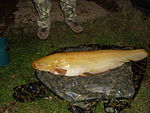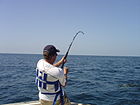Coarse fishing

Coarse fishing (Irish: garbhiascaireacht, Welsh: pysgota bras) is a phrase commonly used in Great Britain and Ireland.[1][2] It refers to the angling for rough fish, which are fish species considered undesirable as food or game fish. Freshwater game fish are all salmonids, particularly salmon, trout and char. Generally, coarse fish are freshwater fish that are not salmonids, though there is often disagreement over whether grayling should be classified as a game fish or a coarse fish.[3]
Fly fishing is the technique usually used for freshwater game fishing, while other angling techniques are usually used for coarse fishing.[4] The sport of coarse fishing and its techniques are particularly popular in the United Kingdom and mainland Europe, as well as in some former British Commonwealth countries and among British expatriates.
The distinction between coarse fish and game fish, terms that developed in the United Kingdom in the early 19th century, has no taxonomic basis [5] Before that time, recreational fishing was a sport of the gentry, who angled for salmon and trout and called them "game fish". There was a view that other fish did not make as good eating, and they were disdained as coarse fish.[6][7] Coarse fish have scales that are generally larger than the scales of game fish,[5] and tend to inhabit warmer and stiller waters.
Bait
[edit]Game fish
[edit]When fishing on rivers for game fish (i.e., brown, rainbow, brook and sea trout, salmon and in some cases grayling), artificial flies, small spinners and lures are a popular choice for many game anglers due their ability to mimic prey items, (such as small invertebrates), on the surface and top layers of the water, enticing the fish into feeding.[8]
General
[edit]Both floating and sinking flies and lures can be used to fish either on the surface or in the upper layers of the water. Usually, in the summer months, a spinner or fly manoeuvre across the surface will bring about a take from a fish due to the tendency of fish to move into the warmest part of the water, the surface and first layer—about 18 inches (46 cm)—of water below.
Coarse fish
[edit]When fishing a river for coarse fish species, such as chub, barbel, roach, dace and bream, the favourite hook baits tend to be maggot (white, red, and bronze), caster (maggot chrysalis), worm, cheese, pellets (halibut, trout, and carp), boilies (round boiled baits typically made with fish meal, milk, and soya) and luncheon meat.
Loose feed can be any of the above baits with a particle bait, sometimes in the form of hemp seed or a manufactured fishmeal ground bait.
For most species, hook baits will work. When targeting more specific species, such as specimen carps, baits such as boilies, large pellets, large bunches of maggots, floating baits, large lungworm, tiger nuts, and meat chunks from cat food can work well. Micro pellets softened along with ground bait can be fed alongside all hook baits.
Predatory fish such as pike, zander, perch, and eels can be caught using either dead or live bait, typically in the form of a small fish such as a live roach. However, it is worth noting that some fishing venues prohibit the use of live bait.
Spinning, the use of an artificial lure, is also used for predators.
Licences and fees
[edit]
For all anglers in England and Wales, anyone aged 17 and over must purchase a valid rod licence before fishing. Children under 13 do not need a licence, and children aged 13–16 must get a free junior licence.[9] This will enable anglers to legally fish in England and Wales for non migratory trout and coarse fish.
A single rod licence will enable an angler to fish with up to three[9] rods at any one time.
Most commercial fisheries and some rivers are operated on a day ticket basis. In the UK, these can range in price. They are usually paid on the bank with a representative of the venue collecting the fees from anglers from the peg (fishing spot) at some time during the day, or prior to commencing fishing. In some cases, season tickets can be purchased.
Some lakes and river stretches are operated by angling clubs which charge annual membership fees. Application forms can be available from local tackle shops or angling club websites. Fishing venues can be operated by syndicates, usually by invitation. They can sometimes be joined by contacting a senior member of the syndicate.
Tackle and technique
[edit]The most common types of tackle is the rod and reel, the rod being typically between 8 and 13 feet (2.4–4.0 m) long, and manufactured of tubular carbon fibres or splits of Tonkin bamboo. A reel is then attached near the base of the rod to hold a long length of line, which is run to the tip of the rod through eyelets. Once cast out, the line can be retrieved by winding a handle on the reel.
However, the use of "poles" is also widespread. Here, the line is fixed to the very tip of the rod, with no reel used: in order to retrieve the line, the pole itself is taken apart until the line can be swung to hand. Poles are often very long in order to increase the angler's range—up to 52 feet (16 m).
The main techniques used are float fishing, bottom fishing (legering) and lure fishing.
- In float fishing, the bait is suspended beneath a float made of hollow plastic, wood or quill. The top of the float is usually painted a bright colour and bites are indicated by the top of the float dipping under the surface of the water, or moving up in the water.
- Legering does not use floats. Instead the bait is held on the bottom of the lake or river by a sinker or large weight. Bites are detected by watching the quiver tip of the rod for movement, or with the use of electronic bite alarms, and more advanced tackle such as PVA bags or mesh.
- With lure fishing, either a brightly coloured fishing lure or a small baitfish attached to the hook is towed through the water to attract predatory fish such as pike, zander and perch.
Fly fishing techniques may also be used for certain species, such as grayling or chub.
For float and leger fishing, groundbait is usually thrown into the water to attract fish to the area. Typical baits include nightcrawlers, maggots, bread and sweet corn. Lately, advancements in technology and market competitiveness have led to many types of other ingredients being introduced, including chemicals, such as betaine, that stimulate the feeding response in fish. Boilies are popular baits for carp fishing.
Target species
[edit]The main target species for this type of angling include:
| Name | Scientific name | Image | Variants |
|---|---|---|---|
| Barbel | Barbus barbus | 
|
|
| Bream | Abramis brama | 
| |
| Common carp | Cyprinus carpio |  |
Grass, Common, Crucian, Leather, Mirror |
| Chub | Squalius cephalus | 
| |
| Dace | Leuciscus leuciscus | 
| |
| Ide | Leuciscus idus | 
| |
| Perch | Perca fluviatilis | 
| |
| Pike | Esox lucius | 
| |
| Roach | Rutilus rutilus | 
| |
| Rudd | Scardinius erythrophthalmus | 
| |
| Tench | Tinca tinca | 
| |
| Wels catfish | Silurus glanis | 
| |
| Zander | Sander lucioperca | 
|
Less targeted species include:
- Bullhead (Cottus gobio)
- Eel (Anguilla anguilla)
- Gobio gobio (gudgeon)
- Common minnow (Phoxinus phoxinus)
- Powan (Coregonus clupeoides)
- Ruffe (Gymnocephalus cernua)
- Three-spined stickleback (Gasterosteus aculeatus)
See also
[edit]Notes
[edit]- ^ "Pysgotfa - Eisteddfa Fisheries - Criccieth -". www.eisteddfa-fisheries.com. Retrieved 10 September 2021.
- ^ Component Specification NFQ Level 6 Coarse Angling 6N0640 www.qqi.ie, accessed 10 September 2021
- ^ Beattie, Rob (2012-03-22). Fishing, A Very Peculiar History. Andrews UK Limited. ISBN 978-1-908759-85-6.
- ^ Larry (2015-08-13). "What is Fly Fishing?". Blue Ridge Mountain Life. Retrieved 2022-08-24.
- ^ a b c Bob McDowall. Coarse fish - Cyprinids – goldfish, carp and others, Te Ara - the Encyclopedia of New Zealand. Updated 14 November 2012.
- ^ Lowerson[page needed]
- ^ "The Fishing Museum Online - Game or Coarse?". www.fishingmuseum.org.uk. Retrieved 2023-11-14.
- ^ "Best Freshwater Fishing Lures". takemefishing.org. November 22, 2023. Retrieved November 22, 2023.
- ^ a b "Buy a rod fishing licence - GOV.UK". www.gov.uk. Retrieved 2018-04-17.
References
[edit]- Cholmondeley-Pennell, Henry (1893) Fishing: Pike and other coarse fish 5th edition, revised. Longmans, Green.
- Cooper, Dave (2004). "First Class Fishing". Fishing Magic.
- Lowerson, John (1993). Sport and the English middle classes, 1870–1914. Manchester University Press. ISBN 0-7190-3777-8.
- Tranter, Neil (1998). Sport, Economy and Society in Britain 1750–1914. Page 101. Cambridge University Press. ISBN 0-521-57217-7.
Further reading
[edit]- Bailey, John (2008). Where to Coarse Fish in Britain and Ireland. New Holland Publishers Ltd. ISBN 978-1-84537-934-6.
- Marston, Robert Bright (1883) Coarse Fish Culture Clowes and Sons, Limited.
- Partner, Steve (2007). Coarse Fishing Basics. ISBN 978-0-7537-1586-4.
External links
[edit]- Carp and Coarse Fishing Baits
- UK Coarse Fisheries
- Fishing for fun
- Henfold Lakes: Coarse Fishery Pictures from Surrey, England
- Anglers net: Coarse fishing articles
- Coarse fishing venues on google maps. Angling Social Networking Archived 2008-10-11 at the Wayback Machine
- Some basic information on choosing coarse fishing tackle a.k.a. carp fishing tackle
- Have questions about coarse fishing Coarse fishing questions
- Beginners guide to coarse fishing Archived 2015-04-02 at the Wayback Machine






